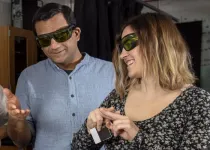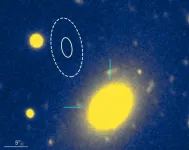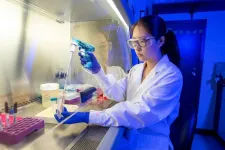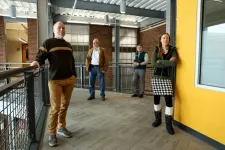(Press-News.org) Topological insulators (TIs) are among the hottest topics in condensed matter physics today. They’re a bit strange: their surfaces conduct electricity, yet their interiors do not, instead acting as insulators. Physicists consider TIs the materials of the future because they host fascinating new quantum phases of matter and have promising technological applications in electronics and quantum computing. Scientists are just now beginning to uncover connections between TIs and magnetism that could unlock new uses for these exotic materials.
A new study led by Illinois Physics Professor Fahad Mahmood now reports the experimental discovery of a hidden gap in the electronic band structure of the intrinsic magnetic TI manganese bismuth telluride (MnBi2Te4). The team demonstrated that MnBi2Te4 is gapless in equilibrium yet develops a gap when exposed to different orientations of circularly polarized light. This discovery settles a decade-long debate over the existence of the predicted yet previously unverified gap.
These findings were published on January 21, 2025, in the journal Nature Physics and represent the first study to engineer new states in MnBi2Te4 using light.
Magnetic topological insulators
Non-magnetic topological insulators famously obey a rule called time-reversal symmetry (TRS), where the laws of physics operate the same way backward in time as they do forward. To illustrate this idea, suppose we tracked the currents of a non-magnetic TI using a video camera. TRS says that we’d see the same behavior whether the video was played forward or backward, the only difference being that the currents would flow in the opposite direction when run in reverse. This TRS property enables TIs’ characteristic surface currents and interior insulating abilities.
But sometimes, breaking TRS is useful. In the last few years, scientists have been working on a new generation of TIs: magnetic ones. Unlike their non-magnetic cousins, magnetic TIs do not obey TRS. Their magnetic components, called spins, change the rules electrons usually follow in conventional TIs by disrupting their surface-conducting abilities, effectively turning TIs into insulators. Although this might sound counterproductive given TRS’s usefulness, breaking TRS can create new quantum phases of matter.
“A big motivating factor for studying magnetic topological insulators is the presence of the quantum anomalous Hall effect,” says Illinois Physics graduate student and lead author Nina Bielinski. “This effect is not observed in non-magnetic topological insulators.”
The quantum Hall effect (QHE) is a phenomenon that occurs in the presence of a strong magnetic field and low temperatures, when the resistance in non-magnetic TIs becomes restricted to certain values. In this strange phase, currents can flow with little to no energy loss, quantum states can be protected against environmental influence, and previously unseen particle excitations can emerge. Realizing the QHE could therefore enable energy-efficient devices, protect qubits for quantum computing applications, and reveal never-before-seen physics. But the requirement of a high external magnetic field makes studying the QHE very difficult in practical settings.
On the other hand, TRS-breaking magnetic TIs exhibit a version of the QHE that doesn’t require magnetic fields at all—the quantum anomalous Hall effect (QAHE). Eliminating the need for an external magnetic field using magnetic TIs would make QHE phases much more accessible.
At the center of current magnetic TI research—and a recent controversy—is the material MnBi2Te4. Whereas other magnetic TIs get their magnetism from magnetic impurities, the magnetism of MnBi2Te4 is already “built in,” originating from the orderly arrangement of its manganese atoms.
Mahmood notes, “Over the last decade or so, people have been wondering if we can create undiscovered phases in topological insulators without using strong external magnetic fields. What happens, for instance, when we mix in something intrinsic like magnetism? Manganese bismuth telluride is a perfect model for answering these questions because it’s both antiferromagnetic and a topological insulator.”
A hallmark of TRS breaking in magnetic TIs is the appearance of a band gap—a region forbidden to electrons. But there’s one problem: although some research groups have experimentally observed a gap in MnBi2Te4, other groups have not. To resolve the controversy, Mahmood and his team took a new approach, turning their focus to the material’s band structure.
It’s all about band structure
Quantum mechanics tells us that the electron energy levels in an isolated atom are quantized—that is, electrons can only have specific energies. However, when multiple atoms come together to make a material, the electrons’ allowed energies form continuous bands. Forbidden regions, or gaps, between these bands can also arise, constraining where the electrons can go and what they can do. Knowing how a material’s electrons stack up in these bands and whether there are any gaps between them tell us the material’s behaviors and properties.
A non-magnetic TI has two cone-shaped bands in its band structure, a lower band and an upper band, which are counterfacing and have no gap between them, instead meeting at a single point. But breaking TRS—say, in a magnetic TI, for example—opens a gap between the cones, changing the shape, or topology, of the band structure. However, as mentioned earlier, experiments have neither convincingly pinned down nor ruled out the existence of a gap, potentially suggesting that TRS is not broken in MnBi2Te4 after all.
To confirm whether MnBi2Te4 has a gap or not, the experimentalists used a technique called angle-resolved photoemission spectroscopy (ARPES). Based on the famous photoelectric effect, ARPES measures the energies of electrons emitted from a material’s surface when light is shined on it. The incoming light interacts with the surface’s electrons, ejecting them from the surface. The emitted electrons and their outgoing angles are then picked up by detectors, and their kinetic energies and momenta are recorded. From this information, scientists can reconstruct the material’s band structure.
Like all magnets of its kind, MnBi2Te4 has two temperature-dependent phases. “As you cool this material down,” Mahmood explains, “it goes through a phase transition and its properties change drastically.”
In the low-temperature magnetically ordered (antiferromagnetic) phase, spins tend to anti-align, whereas in the high-temperature magnetically disordered (paramagnetic) phase, the spins have no preferred orientation.
Using ARPES, the team mapped out MnBi2Te4’s band structure in equilibrium in both phases and found no gap in either, in agreement with some previous studies but at odds with others. Was MnBi2Te4 really gapless? Or was the gap hiding?
Where, oh where, is the gap?
Not to be deterred, the team decided to take a closer look using another technique.
“Recent interest has focused on using laser light to fundamentally change the properties of materials,” says Mahmood. “If I shine one type of light onto a sample, it goes into one phase. If I shine another type of light, the sample goes into another phase. This is called Floquet-Bloch manipulation.
“There have been a lot of theoretical predictions on driving materials out of equilibrium with Floquet-Bloch manipulation—in particular, using circularly polarized light to change topological phases of matter. But experiments have been limited to only a few materials. People tried it with graphene. It wasn’t that successful. Then they tried it with some non-magnetic topological insulators, and it was successful.”
In fact, Floquet-Bloch manipulation using circularly polarized (CP) light was experimentally shown to open a gap in the band structures of some non-magnetic TIs. Perhaps the same technique could open a gap in MnBi2Te4, too.
The researchers combined Floquet-Bloch manipulation with ARPES: they first shined right-CP (RCP) light on their MnBi2Te4 sample, simultaneously tracking its band structure in time using ARPES. They then repeated this procedure using left-CP (LCP) light.
Mahmood notes, “We found that the material goes into a different state depending on whether the light is circulating clockwise versus counterclockwise.”
The experiment demonstrated that in both the low- and high-temperature phases, both LCP light and RCP light indeed create a gap—the hidden gap the team was looking for! And the researchers found a startling asymmetry: in the low-temperature phase, RCP light produced a gap size almost twice as large as the gap size produced by LCP light—an undeniable sign that TRS is broken. However, the gap asymmetry was not observed in the high-temperature phase.
So how does this show TRS breaking?
Think about it this way: suppose you recorded a video of, say, light moving clockwise. If you played the video backwards, the light would move counterclockwise instead. In other words, reversing the orientation of CP light is equivalent to reversing time. And because the RCP gap was twice as large as the LCP gap, reversing time changes how the material responds to the light—the definition of TRS breaking.
How does the gap arise?
Where does the asymmetry come from? How does it physically arise?
Because of complex interactions, electrons in a material often behave as if they are non-interacting and have a different mass than their actual mass. The researchers speculated that the gap asymmetry arose from interactions between this effective mass and the material’s intrinsic magnetism.
Bielinski explains, “The fact that we saw unequal gaps in the low-temperature phase yet identical gaps in the high-temperature phase suggested that this difference was tied to some aspect of magnetism.”
The researchers assumed that the effective mass varied along the surface according to the influence from magnetic defects.
“Sample surfaces are hardly perfect and have numerous defects. For instance, atoms of one type can occupy incorrect lattice positions,” Bielinski shares. “These defects give rise to variations in spin alignments across the sample. In turn, these spin variations affect the interaction between the effective mass and the circularly polarized light.”
The model showed that CP light tweaks the effective mass, shifting it up or down depending on the light’s orientation. In particular, if the effective mass is non-uniform, then the shifts caused by LCP light versus RCP light will not be equal, leading to unequal band gap sizes—precisely what the team saw in their experiment.
While the researchers acknowledge the sample surface probably has more features than just site defects, scanning tunneling microscopy experiments confirmed the presence of these magnetic defects in their sample, showing that this model is plausible and effective at describing the mechanism behind the gap asymmetry.
A new chapter in magnetic TI research
For his part, Mahmood is relieved to have finally found a satisfying resolution to the gap controversy.
“Magnesium bismuth telluride is an interesting system where theory predicted a certain behavior, yet no one saw it experimentally,” Mahmood says. “But when we drove the system very strongly with light using the Floquet-Bloch technique, we finally saw something that agrees with theory.”
But the band structure isn’t the only feature of Floquet-Bloch-engineered MnBi2Te4 that the team wants to study.
“So far, we’ve only measured our material’s band structure,” Mahmood points out. “But there are other facets waiting to be explored, including measurements of electrical conductivity and quantum Hall effects that could arise from Floquet-Bloch manipulation.”
This study is the first to apply Floquet-Bloch engineering in MnBi2Te4. And it certainly won’t be the last. With MnBi2Te4’s gap under their belts, the researchers know they’ve only scratched the surface of what’s possible with magnetic TIs and Floquet-Bloch manipulation.
“Now that we’ve found ways to open gaps, we hope to extend our work to other materials and actually understand why we observe behaviors in certain materials and not in others,” Mahmood concludes.
This work was funded by the U.S. Department of Energy, Office of Basic Energy Sciences under Grant No. DE-SC0021238; by the Gordon and Betty Moore Foundation’s EPiQS program under Grant No. GBMF11069; and by the National Science Foundation’s Illinois Materials Research Science and Engineering Center program under Grant No. DMR-1720633. Any opinions, findings, conclusions or recommendations expressed in this material are those of the researchers and do not necessarily reflect the views of the funding agencies.
END
Illuminating an asymmetric gap in a topological antiferromagnet
2025-01-21
ELSE PRESS RELEASES FROM THIS DATE:
Global public health collaboration benefits Americans, SHEA urges continued support of the World Health Organization
2025-01-21
The Society for Healthcare Epidemiology of America (SHEA) wants to emphasize the importance of global partnerships in addressing health threats that impact all of us, as Americans and global citizens. We urge President Trump to reconsider the decision to terminate the U.S. relationship with the World Health Organization (WHO). The most effective way to address emerging health threats is through collaborative efforts with international partners. Eliminating U.S. involvement in the WHO would leave our country—and the world—more vulnerable to infectious diseases and less prepared to manage pandemics, fight emerging health threats, ...
Astronomers thought they understood fast radio bursts. A recent one calls that into question.
2025-01-21
Astronomer Calvin Leung was excited last summer to crunch data from a newly commissioned radio telescope to precisely pinpoint the origin of repeated bursts of intense radio waves — so-called fast radio bursts (FRBs) — emanating from somewhere in the northern constellation Ursa Minor.
Leung, a Miller Postdoctoral Fellowship recipient at the University of California, Berkeley, hopes eventually to understand the origins of these mysterious bursts and use them as probes to trace the large-scale structure of the universe, a key to its origin and evolution. He had written most of the computer code that allowed ...
AAAS announces addition of Journal of EMDR Practice and Research to Science Partner Journal program
2025-01-21
Journal of EMDR Practice and Research (JEMDR), launched in 2007, is devoted to integrative, state-of-the-art papers about EMDR therapy. It is a broadly conceived interdisciplinary journal that stimulates and communicates research and theory about EMDR therapy and its application to clinical practice. The journal publishes articles on all aspects of EMDR therapy and Adaptive Information Processing (AIP) theory. JEMDR is co-lead by Jenny Ann Rydberg, MA, PhdD cand. (University of Lorraine, Nancy, France) and Derek Farrell, PhD, MBE (Northumbria, Newcastle-upon-Tyne, UK).
As a member of the Science Partner Journal program, JEMDR will publish on a continuous basis under ...
Study of deadly dog cancer reveals new clues for improved treatment
2025-01-21
Researchers at the University of Florida College of Veterinary Medicine and the UF Health Cancer Center have identified a crucial link between a gene mutation and immune system signaling in canine hemangiosarcoma, a discovery that could lead to better treatments for both dogs and humans with similar cancers.
The research focuses on hemangiosarcoma, an aggressive cancer that forms malignant blood vessels in dogs. This life-threatening condition is difficult to diagnose early, as tumors can grow silently before rupturing without warning, leading to emergencies. ...
Skin-penetrating nematodes have a love-hate relationship with carbon dioxide
2025-01-21
Key takeaways
Globally, over 600 million people are infected with the skin-penetrating threadworm, Strongyloides stercoralis, mostly in tropical and subtropical regions with poor sanitation infrastructure.
Infections are treated with ivermectin, but some nematodes are starting to develop resistance to this first-line drug.
UCLA biologists have discovered that the nematodes respond differently to carbon dioxide at different stages in their life cycle, which could help scientists find ways to prevent or cure infections by targeting ...
Fewer than 1% of U.S. clinical drug trials enroll pregnant participants, study finds
2025-01-21
PROVIDENCE, R.I. [Brown University] — A new study by researchers from the Brown University School of Public Health found that pregnant women are regularly excluded from clinical drug trials that test for safety, raising concerns for the efficacy of these medications for maternal and child health.
The study, published in the American Journal of Obstetrics and Gynecology, analyzed 90,860 drug trials involving women ages 18 to 45 from the past 15 years and found that only 0.8% included pregnant participants. ...
A global majority trusts scientists, wants them to have greater role in policymaking, study finds
2025-01-21
In what is considered the most comprehensive post-pandemic survey of trust in scientists, researchers have found a majority of people around the world carry widespread trust in scientists — believing them to be honest, competent, qualified and concerned with public well-being.
Researchers surveyed more than 72,000 individuals across 68 countries on perceptions of scientists’ trustworthiness, competence, openness and research priorities.
The results, published in the journal Nature Human Behavior, also showed the general public’s desire ...
Transforming China’s food system: Healthy diets lead the way
2025-01-21
According to the study published in Nature Food, China’s current trajectory is misaligned with the United Nations Sustainable Development Goals (SDGs). The researchers assessed potential pathways for achieving the SDGs in China by transforming its food system, focusing on dietary changes, climate change mitigation, ecological conservation, and socio-economic development. “Action across all areas of the food system is required to achieve a sustainable food system and efficiently address the wide range of social and environmental ...
Time to boost cancer vaccine work, declare UK researchers
2025-01-21
UK oncology researchers have come together to write the first ever national thought leadership strategy report into cancer vaccine advances and the opportunities these present for those affected by cancer. The strategy report has been published in Cambridge University Press journal Cambridge Prisms: Precision Medicine.
Cancer vaccines hold the potential to revolutionise cancer treatment. These vaccines leverage neoantigens to activate the immune system against tumours, offering a personalised approach to combat cancer. This transformative potential is particularly significant in light of recent advancements in oncology, including ...
Colorado State receives $326M from DOE/EPA to improve oil and gas operations and reduce methane emissions
2025-01-21
The Department of Energy and Environmental Protection Agency have awarded $326 million to three Colorado State University research projects that aim to improve U.S. oil and gas operations and reduce methane emissions nationwide.
The EPA’s Methane Emissions Reduction Program is providing the funding to the CSU Energy Institute and faculty working across multiple departments in the Walter Scott, Jr. College of Engineering, with the goal of helping oil and gas operators improve operational efficiency and manage emissions. The efforts will also support activity to build an inventory of methane emissions, ...



